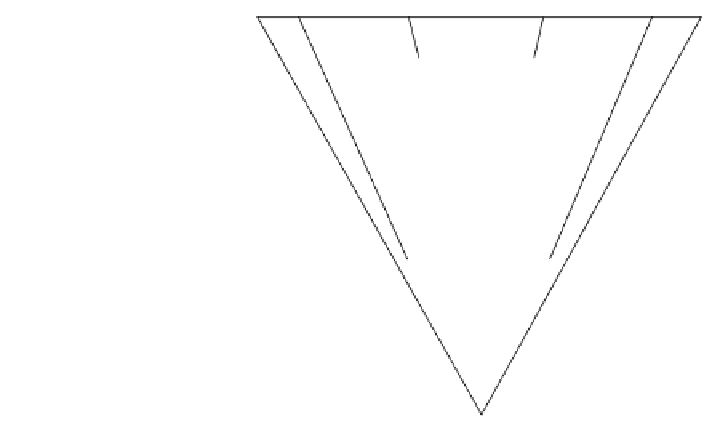Geology Reference
In-Depth Information
Fig. 3.7 A (alkali
feldspar)
-
P (plagioclase)
-
F
(feldspathoid) diagram of
Birunga rocks (after Ferguson
and Cundari 1975)
A
P
Trachyte
Latite
D
A
Te p h r i t i c -
Leucite -
Phonolite
Phonolitic -
Leucite -
tephrite
C
Phonolitic
leucitite
Te p h r i t i c
leucitite
B
Leucitite
F
labradorite with orthoclase rims have been termed as absarokite. The rock is named
after the Absaroka Range, near Yellowstone Park, USA, where it was
rst
described.
A leucocratic rock consisting of aegirine augite and leucite or pseudoleucite has
been termed as fergusite. Yakutites are rocks characterized by the presence of
orthoclase, aegirine and kalsilite (up to 40 vol%). These rocks have been described
from the Munrun complex in the eastern part of Siberia (Orlova et al. 1986).
When a rock is similar in mineral composition to absarokite, but contains smaller
amount of augite and olivine, then it is called banakite, which may contain quartz,
in that case olivine is absent.
The name shoshonite is coined after the type locality near the Shoshone River in
Yellowstone Park. It is basically a trachy-andesite composed of olivine, augite and
plagioclase phenocrysts in a groundmass of K-feldspar, plagioclase and dark-colour
glass.
3.3 Classi
cation Based on Niggli Values
Lamproitic rocks are those, which have Niggli k [molar K
2
O/(K
2
O+Na
2
O)] and
mg [molar MgO/(MgO + FeO + Fe
2
O
3
+ MnO)] values exceeding 0.80. Lamproites
have extreme composition with respect to K
2
O and MgO (high) and Al
2
O
3
(low)
contents (Fig.
3.8
). There are however, many rocks with typical lamproitic min-
eralogy which has Niggli
0.84 (e.g. Noonkanbah lam-
proite, West Kimberly, Australia (Jaques et al. 1986). Mitchell and Bergman (1991)
also showed that most olivine lamproites from the Ellandale
'
mg
'
ranging from 0.49
-
field of Western



















































































Search WWH ::

Custom Search